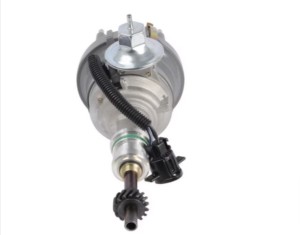In the realm of automotive mechanics, particularly within older vehicle models, the distributor stands as a crucial component of the ignition system. But What Does A Distributor Do In A Car exactly? Essentially, the distributor is the unsung hero ensuring your engine’s combustion process is precisely timed and efficiently executed. It works in close concert with the ignition coil and spark plugs to guarantee the air-fuel mixture ignites at the optimal moment within each engine cylinder’s cycle.
At its core, a distributor operates through a blend of mechanical and electrical principles. Its primary function is to distribute the high-voltage current generated by the ignition coil to the engine’s cylinders in a specific firing order. This intricate process is facilitated by several key components within the distributor:
- Rotating Arm and Camshaft Gear: This assembly securely connects the distributor to the engine’s camshaft, ensuring synchronized rotation.
- Rotor: Positioned inside the distributor cap, the rotor acts as a conduit, channeling electrical current from the ignition coil to the individual contact points within the distributor cap.
- Distributor Cap: This protective housing encloses the rotor and features terminals for each spark plug wire. In older systems, it may also contain contact points (points).
- Points (Contact Points): Found in older distributors, these act as a switch, controlling the flow of high-voltage current within the distributor.
- Ignition Wires: These wires are the pathways for the high-voltage electrical surge, transmitting energy from the distributor to each spark plug.
The Distributor’s Critical Role in Ignition Timing
For optimal engine performance, the spark plug must ignite the air-fuel mixture within the cylinder at a precisely calculated point during the compression stroke. This is where the distributor’s role in ignition timing becomes paramount. The distributor’s timing is initially mechanically set through its geared connection to the camshaft. This mechanical link ensures a base level of synchronization. However, fine-tuning is often necessary. A set screw typically allows for minor distributor rotation, enabling precise timing adjustments, particularly at idle speeds.
Beyond idle, engine operating conditions change, requiring timing adjustments. Many distributors incorporate a vacuum advance mechanism to dynamically alter timing based on engine load. This mechanism responds to varying vacuum levels within the engine, optimizing spark timing for different driving scenarios, such as acceleration or cruising.
Improper distributor timing, or a malfunctioning timing adjustment mechanism, can lead to a range of engine performance issues, varying in severity.
- Spark Occurring Too Early (Advanced Timing): This can result in engine knocking or pinging, accompanied by a noticeable decrease in engine power.
- Spark Occurring Too Late (Retarded Timing): Late spark timing can cause sluggish engine performance, reduced fuel efficiency due to incomplete combustion, and increased emissions.
If left unaddressed, issues stemming from a poorly adjusted or damaged distributor – or even worn distributor cap and rotor – can escalate into more serious problems. These can include rapid spark plug fouling, difficulty starting the engine, engine stalling and stumbling, catalytic converter overheating and potential damage, unusual exhaust odors, and backfiring.
Essential Distributor Maintenance Tips
Vehicles equipped with distributors, generally older models, require more ignition system maintenance compared to modern distributor-less systems. You might encounter common distributor-related symptoms from time to time:
- Intermittent Rough Running: This could indicate a problem with the distributor’s vacuum advance control or a loose set screw causing inconsistent timing.
- Gradual Power Loss: Carbon buildup within the distributor’s internal contacts or worn contact points (in older systems) can impede performance.
- Engine Hesitation During Acceleration: Incorrectly set points or timing misalignment can cause the engine to bog down when accelerating.
Regular maintenance is key for vehicles with distributor ignition systems, including semi-annual or annual inspections. During these checks, carefully inspect the distributor cap for cracks and check for any signs of moisture inside the cap. Clean any accumulated dust or corrosion, especially on the contacts beneath the cap, as these can cause electrical arcing and reduce spark transfer efficiency. Replace the distributor cap, rotor, and points (if applicable) when their contacts show signs of wear or deterioration.
Furthermore, it’s beneficial to conduct an annual engine timing check and make fine adjustments to ensure optimal engine performance and fuel efficiency.
Whether you require a replacement distributor cap and rotor or a complete new distributor assembly, AutoZone offers a wide selection of high-quality parts from trusted brands like Duralast.
FAQ: Common Questions About Car Distributors
What are the telltale signs of a failing distributor in a car? Common indicators of a failing distributor include engine stalling, misfires, backfiring, and difficulty starting the engine. However, accurate diagnosis is crucial as these symptoms can also stem from other engine issues.
How can I effectively diagnose distributor problems in my car? Diagnosis typically begins with a visual inspection of the distributor components. Subsequently, specialized tools like a timing light can be used to assess operational timing, and resistance checks can help identify wiring damage.
Is it feasible to replace a distributor myself, or is professional assistance recommended? While DIY distributor replacement is possible, it’s a highly precise procedure. Without proper tools and a detailed service manual, seeking professional mechanic assistance is generally advisable.
Are electronic distributors superior to traditional mechanical distributors? Electronic distributors offer advancements in durability, reduced maintenance needs, and enhanced reliability compared to older mechanical point-style distributors.
What are the consequences of incorrect ignition timing? Incorrect ignition timing can lead to diminished engine performance, reduced power output, poor fuel economy, and in severe cases, potential engine damage. Precise ignition timing is essential to ensure the air-fuel mixture ignites at the correct moment, preventing damage to internal engine components.
